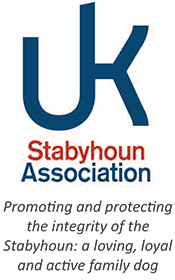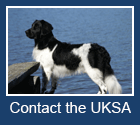Breeding with any animal carries a degree of risk and we are fooling ourselves if we think that testing and screening will one day eliminate all ails. However, where there is an identified risk of dogs passing on hereditary conditions, and where there is a tried and tested method of screening for that condition, it makes sense to do so.
The following article was submitted to us in the hope of raising awareness of Early onset hereditary cataract (EHC). As an association that is keen to promote absolute transparency in breeding and breed health, we were happy to publish it.
“Love is blind!
Patty Berkenbosch (breeder/owner), Winny Schaillee and Jeroen Sijtsma (owners) share their experiences of owning a dog with cataract…
A while ago there was a lecture from the NVSW (Dutch Stabyhoun Association) about eye problems in the breed. This is something we live with every day and therefore we want to share our experiences in the hope that it will raise awareness of the problem in the breed and the potential devastating consequences.
Insecure and scared
Three years ago a beautiful litter was born, which looked fine and healthy. But, we were wrong… At the age of nine months, Douwe became insecure, didn’t dare to go outside in the evening and became startled more easily. A test showed that he suffered from hereditary juvenile cataract on one eye and, a few years later, on both eyes. A few weeks before Douwe was diagnosed, it appeared that the brother of Senna (Douwe’s mom) also had cataract.
Testing the litter
As a breeder, it was awful news – especially in such young dogs that you still feel belong to your family. Senna was tested and it became clear that she had cataract on both eyes. This was why we didn’t notice it before; her eyes both looked the same to us unlike Douwe’s eyes which were different. Somewhat later we got the bad news that also Senna’s daughter, Lobke has cataract. This was a huge shock for everyone as it wasn’t a disease we associated with the Stabyhoun and isn’t mentioned anywhere on the NVSW website. Since then, eight out of Senna’s ten puppies have been tested. Six of those are clear but that only means that they aren’t affected. They could still be genetic carriers.
Insecurity
At first came the insecurity, sadness and anger. Unfortunately there is little advice about how to manage a dog with bad eyesight so you have to learn as you go along. Cataract in older dogs is sad, but not unexpected and it happens over time so the dog has time to adapt to it. Of course older dogs are less active too so they don’t suffer quite so much. Juvenile cataract often evolves faster and the daily challenges for the dogs grow increasingly fast as their world gets smaller and smaller. Things that were normal before suddenly become an obstacle and the dogs grow increasingly insecure. They become significantly more sensitive to smell, sounds, certain objects and are especially anxious in dusk and at night-time.
Sudden fears
Luckily, our dogs are able to compensate for a lack of sight with both smell and hearing, so it is sometime shard to see that they have a problem when they are outside. But then something frightens them such as a moving branch, the loud noise of a big dog that comes from out of nowhere. Normal dogs can quickly evaluate the danger and react accordingly in these situations. But our dogs can’t and this leads to insecurity and stress which can linger for some time. As an owner, you feel powerless, because you can’t protect them against everything.
No concrete steps were taken
Over the years you learn to read your dog better and you know what works and what doesn’t. It sometimes seems like we’re constantly absorbed with thinking about the sight of our dogs, every day. That isn’t the case. The most important lesson we have learnt is that patronizing doesn’t work and that we need to let dogs be dogs. Although these last few years have been difficult, we have learned to live with it – to be sad sometimes but not all the time. However, the thing that keeps upsetting us is that no steps have been taken since this problem was discovered to do something about cataract (and eye problems generally) in the breed. We feel the problem is trivialised and that we are alone in our worries.
Awareness about the disease
We all have a second dog, which is good, because it provides stability, protection and a trusted playmate. But this also highlights the differences between a dog with good and a dog with bad sight on a daily basis. There is so much more we could say about this, all the emotions it brings about and our fear for the insecure future of our beloved dogs. But that is not our goal. With this article, we want to raise awareness of the disease and the consequences amongst breeders. You’re the people who hold the health of our breed in your hands and we hope you will take our stories into account.
Testing
We hope you’re already aware of the possibility to get your dogs tested with an official ECVO-test (in Europe) or CERF-exam in the US. The test is simple, quick and inexpensive (40-50 euro in the Netherlands and approximately 60-70 dollar in the US). The dog is tested for several eye problems and can only be done by an eye-specialist. If you have already had your dog tested, please pass on the results to the Stabyhoun association in your country. Even if you don’t want to breed, testing is important. It gives us all more information and insight into the potential eye problems in the breed. Luckily there are a few owners who have tested their dogs already. We hope many will follow. Most tested dogs are clear, but there are now a few other Stabyhouns known (unrelated to Senna) which also have cataract. Our ultimate goal is to make this test obligatory for all breeding dogs and we hope this article might be a step in that direction. For more information, please take a look at: www.stabyhoun.nl/onzehonden/cataract








